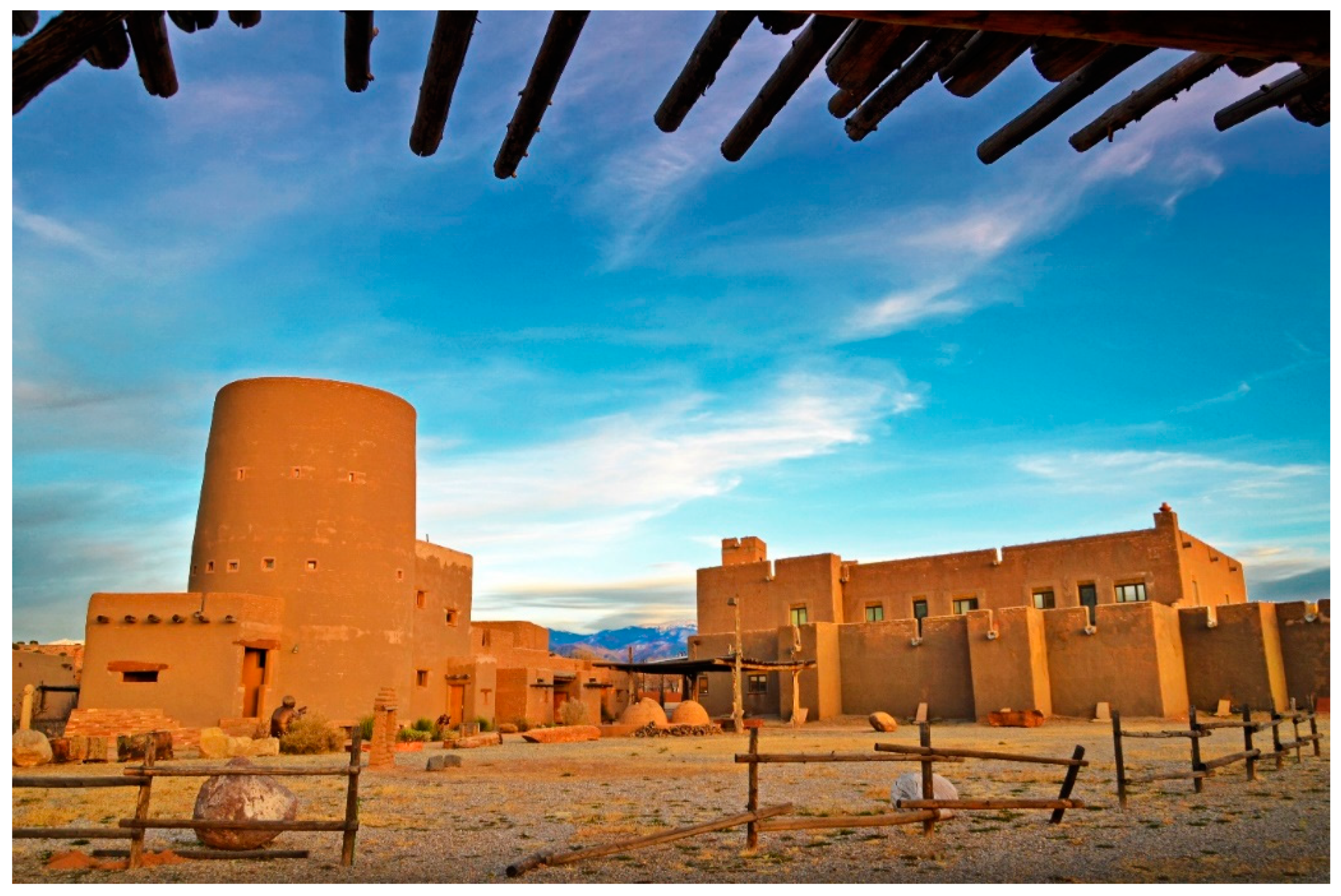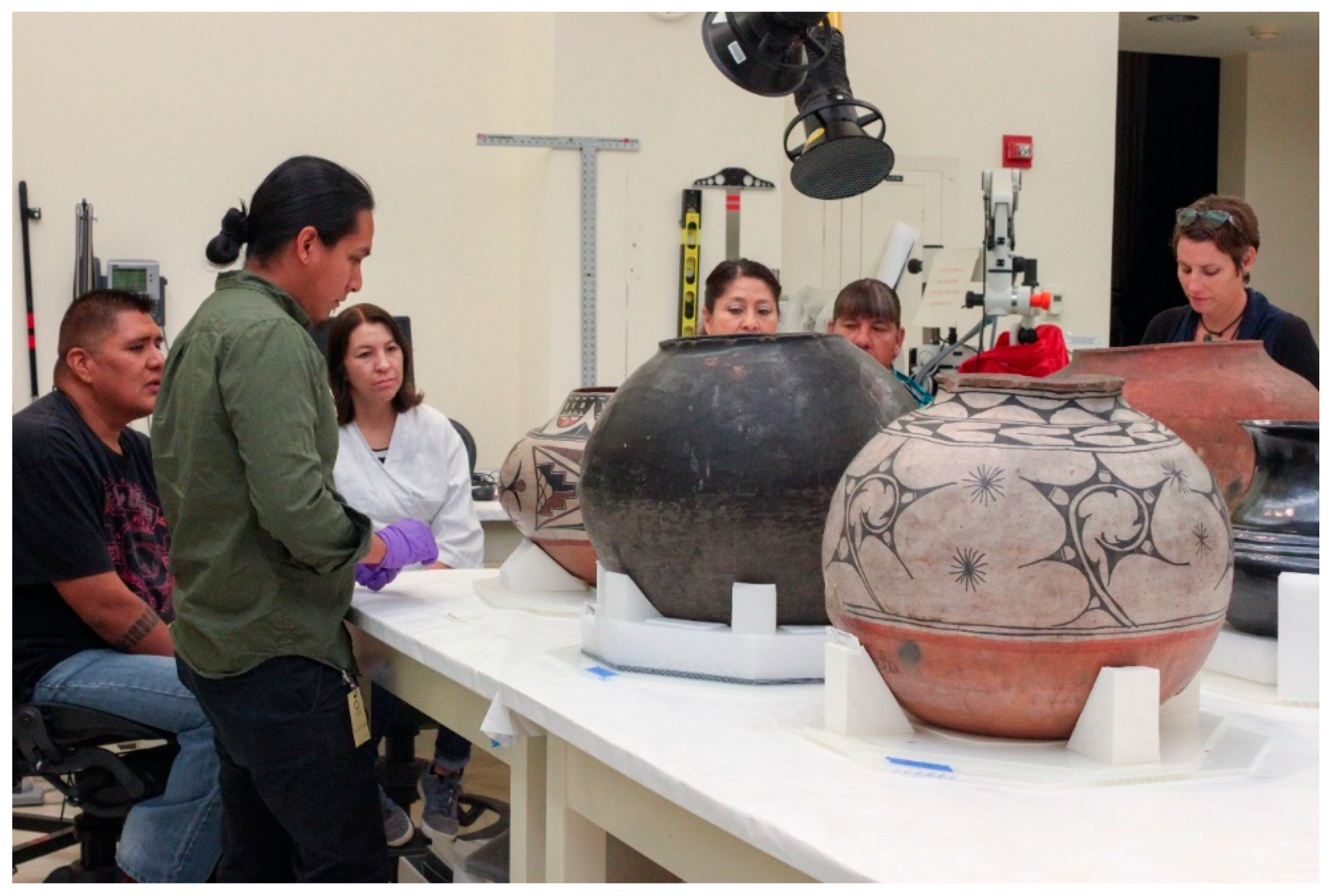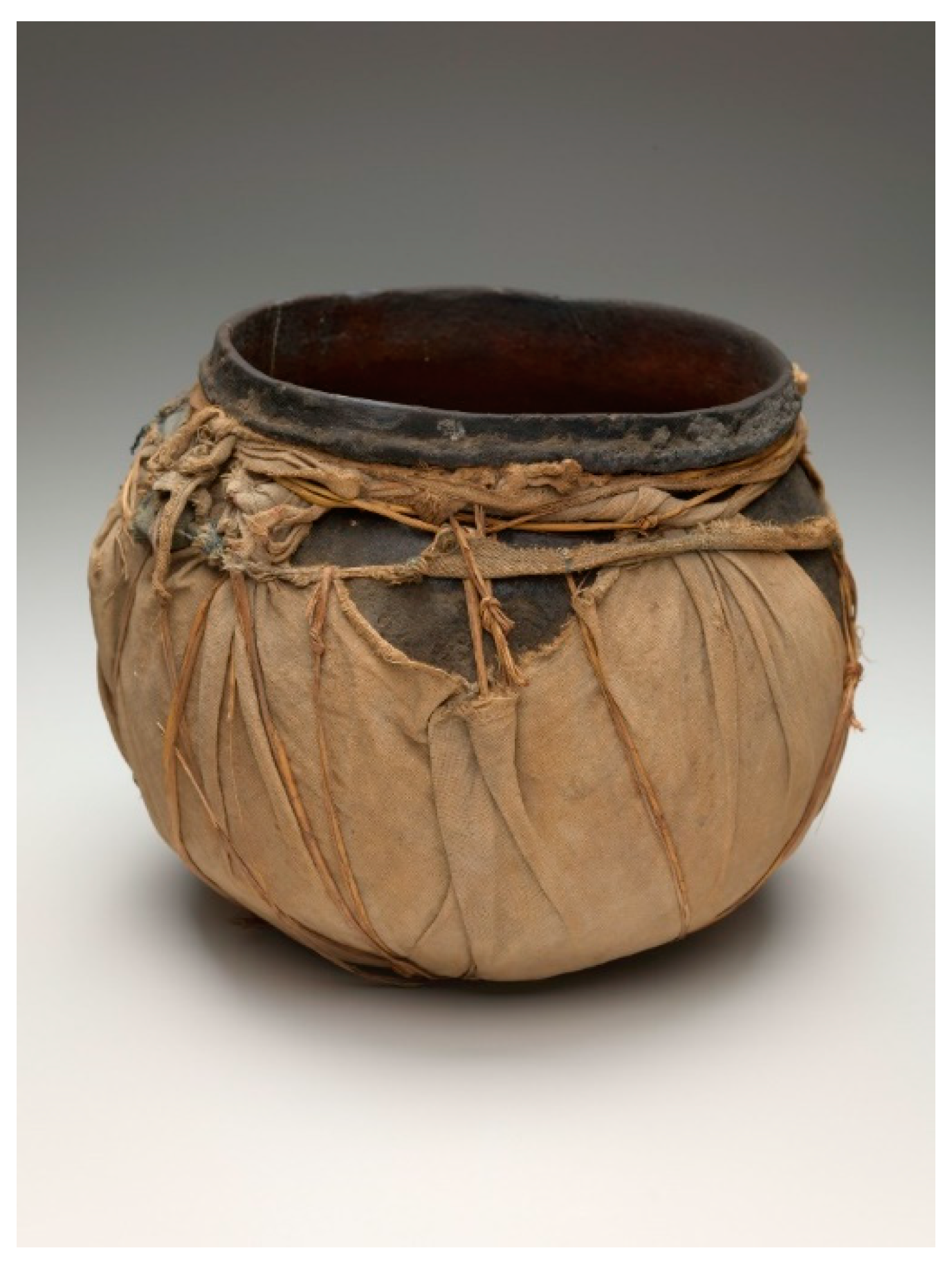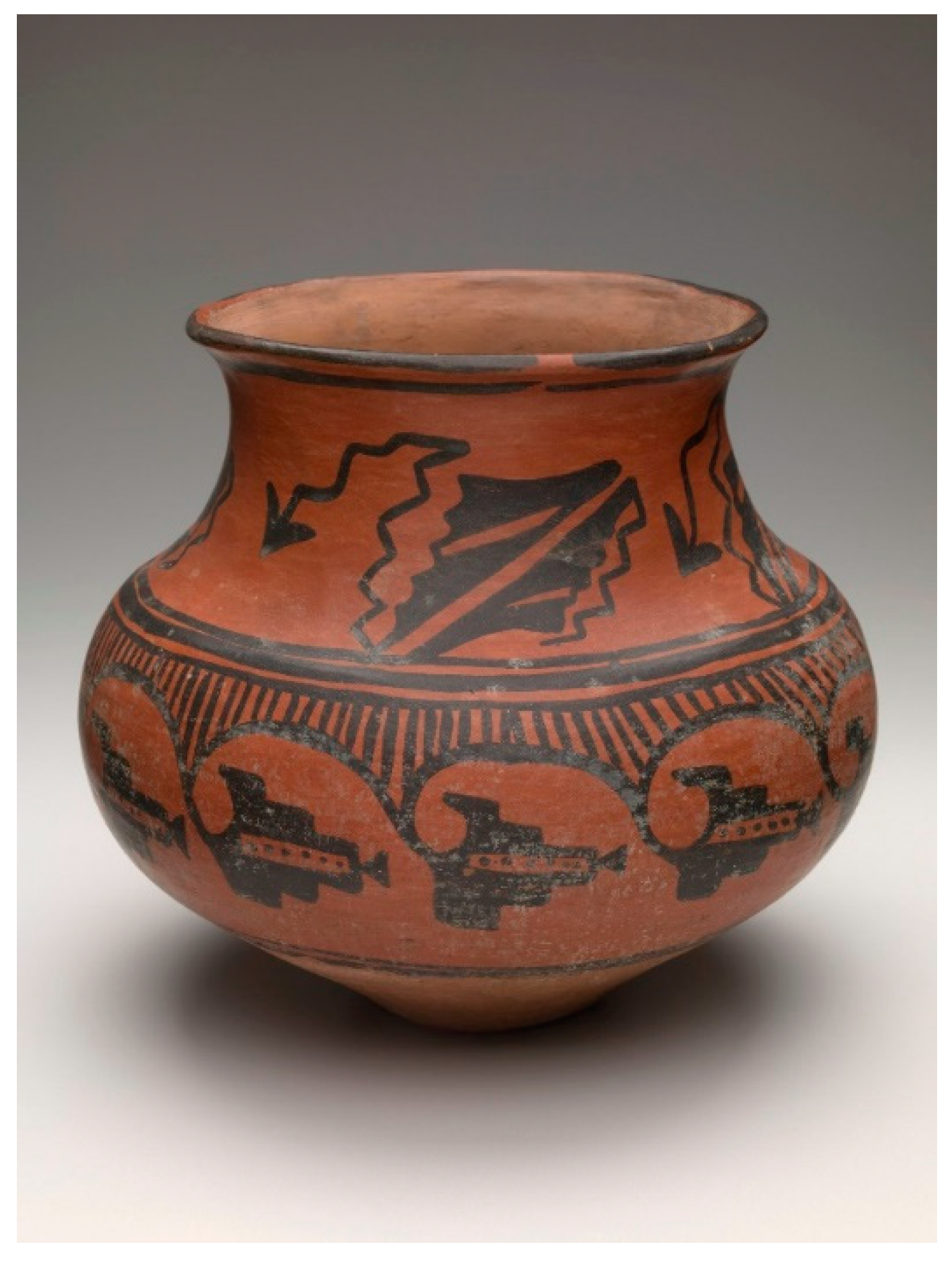A Pathway Home: Connecting Museum Collections with Native Communities
Abstract
1. Introduction
2. The Poeh Cultural Center
“Bringing Home the Collections represents the continuing vitality, relevance, and well-being of Tewa Pueblo communities. The return helps to inspire and bring healing and community well-being. Regathering collections or return of objects helps us remember that we are within Tewa Country; where for millennial people continue to live and thrive, absorbing new ideas while rejecting others but always retaining a strong inner core of Tewa values and principles”.
Posterity is not (or not only) the general public in an unidentified future: it is Indigenous peoples, today. The purpose of this reorientation relates to what many of us who work closely in collections with Native peoples have already come to learn: that more so than connecting with their past, collections and heritage work is about maintaining well-being in their communities in planning for their future, and future generations”.
Haida delegates describe working with objects in emotional and spiritual terms, and in physical ways that differ from how non-Haida scholars might describe the same objects: singing to the objects, talking to them, holding them. As ancestral heritage items, museum collections represent cultural knowledge and history to Haidas today, knowledge and history that is central to Haida culture and identity.
3. Breathing Life into the Pots
In our own work, talking with stakeholders as they handled objects resulted in the most transformative and informative ways for understanding collections. The experience of touching, moving, and turning objects in their hands elicited reactions and triggered stories and muscle memories that would otherwise have remained inaccessible. The physical object—be it sewn skin or fired clay—has the power to evoke responses, observations, questions, and endanger reminiscences that are part of the object’s story.
4. Collections Inspiring Action
This book is dedicated to the children at the Pueblo of Pojoaque Early Childhood Center and all the Tewa children and their teachers. The Pojoaque children first listened to the Sengbeh Enyukeh story in their classroom. One week later, Evone Snowflake Martinez, teacher, and Suzanne Panas walked the children down the hill to the Poeh Cultural Museum. At the museum the children visited the old Tewa pots, made pottery and colored a drawing of a pot before they returned to their classroom. Their short journey is a reminder of the longer journey we as Tewa people will experience as we learn about ourselves through our families, our teachers, and other guides.
5. Conclusions
Funding
Conflicts of Interest
References
- Balachandran, Sanchita, and Kelly McHugh. 2019. Respectful and Responsible Stewardship: Maintaining and Renewing the Cultural Relevance of Museum Collections. In Preventative Conservation: Collection Storage. Edited by Lisa Elkin and Christopher A. Norris. Society for the Preservation of Natural History: American Institute for Conservation of Historic and Artistic Works: Smithsonian Institution: New York: The George Washington University Museum Studies Program, pp. 3–25. [Google Scholar]
- Bolen, Anne. 2019. The Path of a Pot. American Indian Magazine, Fall. [Google Scholar]
- Chavez Lamar, Cynthia. 2019. Smithsonian Institution, Washington, DC, USA. Personal communication with Karl Duncan, Poeh Cultural Center Executive Director. [Google Scholar]
- Hodge, Christina J. 2018. Decolonizing Collections-Based Learning: Experiential Observation as an Interdisciplinary Framework for Object Study. Museum Anthropology 41: 142–58. [Google Scholar] [CrossRef]
- Jordan, Michael Paul. 2015. Documenting and Revitalizing Kiowa Knowledge: Material Culture Studies and Community Engagement. Museum Anthropology Review 9: 80–95. [Google Scholar] [CrossRef][Green Version]
- Krmpotich, Cara. 2015. Teaching Collections Management Anthropologically. Museum Anthropology 38: 112–22. [Google Scholar] [CrossRef]
- Krmpotich, Cara, and Laura Peers. 2013. This Is Our Life: Haida Material Heritage and Changing Museum Practice. Vancouver: University of British Columbia Press. [Google Scholar]
- Naranjo, Tessie, and Lynda Romero, eds. 2018. Sengbeh Enyukeh, Water-Jar Boy: A Tewa Story. Pojoaque Pueblo: The Canelo Project. [Google Scholar]
- Peers and Brown. 2013. Things We Have Learned from the Blackfoot Shirts Project. Brave New World Curator. April 8. Available online: https://pittrivers-americas.blogspot.com/2013/04/things-we-have-learned-from-blackfoot.html?m=1 (accessed on 13 August 2019).
- Shannon, Jennifer. 2019. Commentary: Posterity is Now. Museum Anthropology 42: 5–13. [Google Scholar] [CrossRef]
| 1 | Frances Madeson quoting Pojoaque Pueblo Governor, Joseph Talachy, “9 Ceramic Pots Lead the Way Home, 91 More to Follow”, Indian Country Today, https://newsmaven.io/indiancountrytoday/archive/9-tewa-ceramic-pots-lead-the-way-home-91-more-to-follow-pEbTxAgr6EW6tEN69WzIew/ (accessed on 26 July 2019). |
| 2 | NMAI’s collections have their foundation in the collection of the former Museum of the American Indian (MAI) assembled largely by George Gustav Heye (1874–1957). NMAI was established through Congressional legislation in 1989 (Public Law 101–185), and this included the transfer of MAI’s collections to the Smithsonian. The referenced ceramics entered the MAI collection via donations and purchases made by Heye or MAI staff. |
| 3 | NMAI’s current strategic plan includes as a priority to “reunite Native communities with elements of their heritage under our care through long-term loans, digital access, study visits, and repatriation”. Multiple NMAI staff from the registration, collections management, and conservation departments participated in this project. I served as the program manager working directly with Poeh leadership to plan and implement the project. I am overseeing simliar projects with the Makah Cultural and Research Center and Nohwike’ Bágowa (White Mountain Apache Culture Center). This article draws on my twenty years of experience working on collaborative projects and programs with Native people. |
| 4 | Tewa Pottery Advisors is the official name of the group of artists Poeh Cultural Center worked with throughout the process of the loan, exhibit development, programming, and exhibit opening. The group consisted of individuals from the six Tewa pueblos. There are twenty pueblos in New Mexico. Each is an independent sovereign nation with its own governing body. The languages spoken include Keres, Zuni, Tiwa, Towa, and Tewa, depending on the pueblo’s language group affiliation. I refer to the six pueblos here as Tewa pueblos, because that is the language of Pojoaque, Nambe, Ohkay Owingeh, Santa Clara, San Ildefonso, and Tesuque. Tewa is part of the Tanoan language group. Individuals from these pueblos may self-identify as being from a specific pueblo, such as Pojoaque, but they may also identify as Tewa. |
| 5 | I use the term “objects” in this sentence intentionally as this is the word commonly used to refer to materials in museum collections. Objects can connote stasis and inanimacy, which is counter to how Native people may view these materials. Native people may use different terms to acknowledge the spiritual, cultural, and/or sacred nature of collection items, including, for example, cultural belongings and/or ancestors. |
| 6 | I do not mean to imply this always happens or is immediate. Engagement with collections and the outcomes of that interaction vary due to multiple factors. However, revitalization in any form usually occurs within a community through the efforts of the community itself. |
| 7 | For the remainder of the article, I will use the terms pots and pottery instead of ceramics. Pots and pottery are the terms used by Poeh staff and the Tewa Pottery Advisors. |
| 8 | Similarly, Alison Brown and Laura Peers came to this realization in working with people of the Blackfoot Confederacy on the Blackfoot Shirts Project (see: http://web.prm.ox.ac.uk/blackfootshirts/). In a Pitt Rivers Museum blog post, Brown states, “And we learned these are not ‘objects’: they are also material forms of spirits, of those who made and used them, and those whose physical bodies are present in the hides, sinew, quills and hair. For Blackfoot people, these are ancestors, not museum specimens” (Peers and Brown 2013). |
| 9 | By the 18th century, the Pueblo of Pojoaque population’s was severely diminished. The Pueblo recognizes the fragility of culture and makes efforts to support arts and cultures initiatives. The homepage of their website at http://pojoaque.org reads as follows: “We continue our traditions and practice our culture in these contemporary times. For those things that have been lost or forgotten, we attempt to bring them back and further strengthen the foundation of who we are and where we come from. We learn and adapt; accomplish and progress”. |
| 10 | See: http://poehcenter.org/about/ for the Poeh’s vision and mission statements and objectives (accessed on 27 July 2019). |
| 11 | NMAI consists of three facilities: NMAI on the National Mall in Washington, D.C., where there are exhibits and public programs; NMAI in Lower Manhattan in New York City, where there are exhibits and public programs; and the Cultural Resources Center, where the collections are housed. |
| 12 | Poeh staff and the Tewa Pottery Advisors determined early in the process that they wanted a broad representation of individuals representing Nambe, Ohkay Owingeh, Pojoaque, Santa Clara, San Ildefonso, and Tesuque involved throughout the process. Careful consideration was given to group composition, such as who would make the trips to the CRC to select pots for the loan. The intention was to reflect a shared Tewa sense of identity for the decision-making rather than one focused on a particular pueblo. This became clear with their self-reminders about not selecting pots that had names or signatures associated with them and ensuring that there were participants from all the Tewa pueblos involved at various stages of the project. |
| 13 | Choosing not to treat this pot did not compromise its preservation, because NMAI staff took other measures to protect it during handling, while in transport, and on exhibit. Krmpotich in This is Our Life notes that, in her experience with the Haidas, collections that showed wear indicated to the Haidas that it was a family treasure or well loved (Krmpotich and Peers 2013, p. 58). |
| 14 | Erik identified this pot as one made by his great aunt Dolorita Vigil and said that the line break on the rim of the pot and the thick line around the shoulder of the pot indicate the Vigil family’s artistic trademark. |
| 15 | A useful guide to help museum professionals in their collaborations with Native people is the “Guidelines for Collaboration”, which can be found at http://guidelinesforcollaboration.info. This resource includes specific information regarding cultural considerations when hosting Native people at a museum with Native collections. |
| 16 | The front matter of the book has an image of the children in the Poeh exhibit gallery viewing the pots. |
| 17 | See: https://www.youtube.com/watch?v=4ASFgGofBeU and https://poehcenter.org/theycameback/ (accessed on 15 August 2019). |
| 18 | Bolen quoting Poeh program director Stephan Fadden (Bolen 2019, p. 15). |
| 19 | There is a gallery pamphlet that identifies the pot’s type and pueblo affiliation. |
| 20 | Jim Enote, “Museum Collaboration Manifesto,” http://ashiwi-museum.org, http://ashiwi-museum.org/collaborations/museum-collaboration-manifesto/ (accessed on 26 July 2019). |




© 2019 by the author. Licensee MDPI, Basel, Switzerland. This article is an open access article distributed under the terms and conditions of the Creative Commons Attribution (CC BY) license (http://creativecommons.org/licenses/by/4.0/).
Share and Cite
Chavez Lamar, C. A Pathway Home: Connecting Museum Collections with Native Communities. Arts 2019, 8, 154. https://doi.org/10.3390/arts8040154
Chavez Lamar C. A Pathway Home: Connecting Museum Collections with Native Communities. Arts. 2019; 8(4):154. https://doi.org/10.3390/arts8040154
Chicago/Turabian StyleChavez Lamar, Cynthia. 2019. "A Pathway Home: Connecting Museum Collections with Native Communities" Arts 8, no. 4: 154. https://doi.org/10.3390/arts8040154
APA StyleChavez Lamar, C. (2019). A Pathway Home: Connecting Museum Collections with Native Communities. Arts, 8(4), 154. https://doi.org/10.3390/arts8040154



